Trek’s Checkpoint ALR 5 Driftless is a bikepacking-flavoured off-shoot of the brand’s venerable gravel bike range.
It features a 1x drivetrain, dropper post and even comes with a frame bag as standard.
In testing, I’ve found the bike to be a well-mannered, if not the most exciting, companion. It serves as a quality platform, but you certainly pay for the privilege.
Trek Checkpoint ALR 5 Driftless frame details
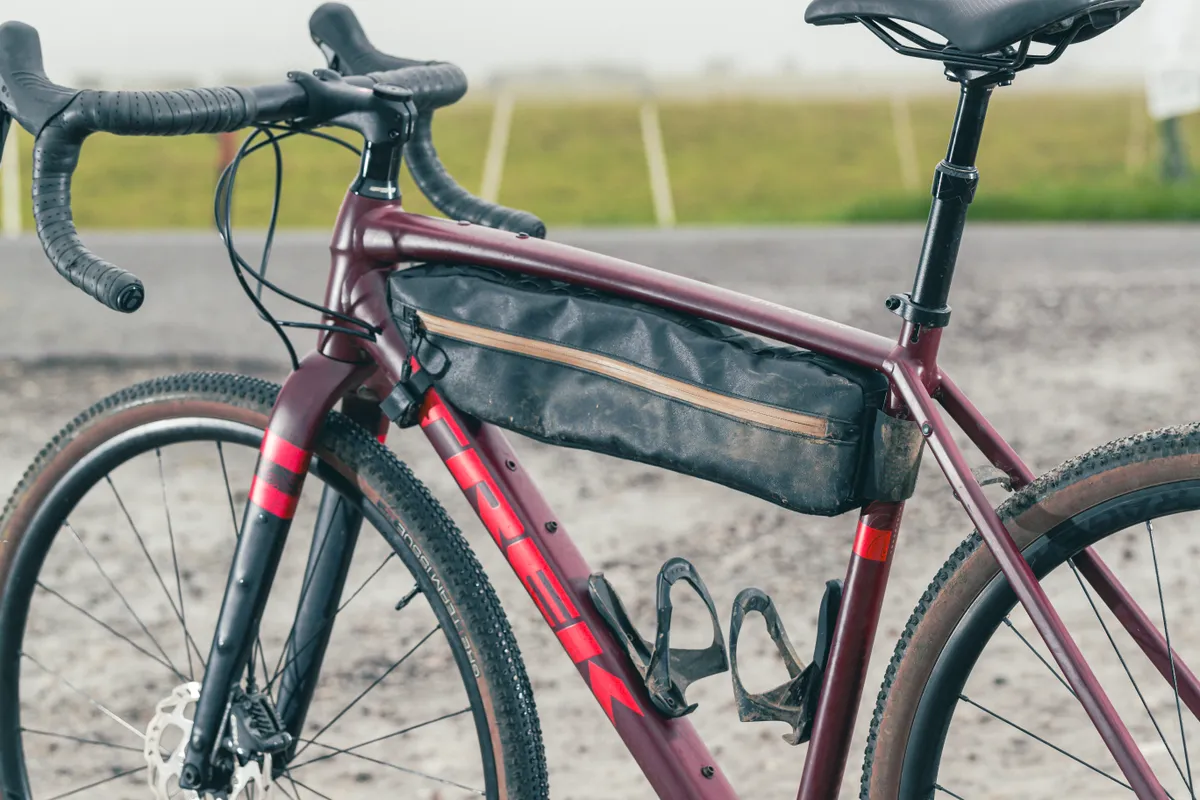
The Checkpoint ALR sits below the carbon Checkpoint SL and SLR, and there are some concessions to be made for the lower asking price.
The bike chiefly misses out on IsoSpeed, a decoupler that splits the seat tube from the top tube, enabling it to flex and take the sting out of bigger hits.
You also don’t get down tube storage, which means you’ll need to resort to traditional methods for carrying spares.
The front end of the aluminium flavour also eschews integration, which in my mind is a benefit because it will make maintenance, particularly servicing or replacing headset bearings, hassle-free.
The cables and hoses are exposed as they exit from the handlebar before running through specific ports in the down tube to their respective locations. You’ll want to run the supplied foam sleeves over the housing, though, to prevent any rattling, because they’re not guided.
Despite the bikepacking influence, the Checkpoint ALR 5 Driftless cuts a fairly traditional figure. It’s constructed from Trek’s 300 Series Alpha Aluminium, the lightest of the American brand’s aluminium line-up.
It all results in a 1,490g painted frame weight in a size 56cm (claimed), with the fork adding a further 580g.
The gently sloping top tube and larger triangular down tube meet Trek’s signature tapered head tube.
Dropped seatstays are off the menu and the thin, round seat tube is fairly traditional.
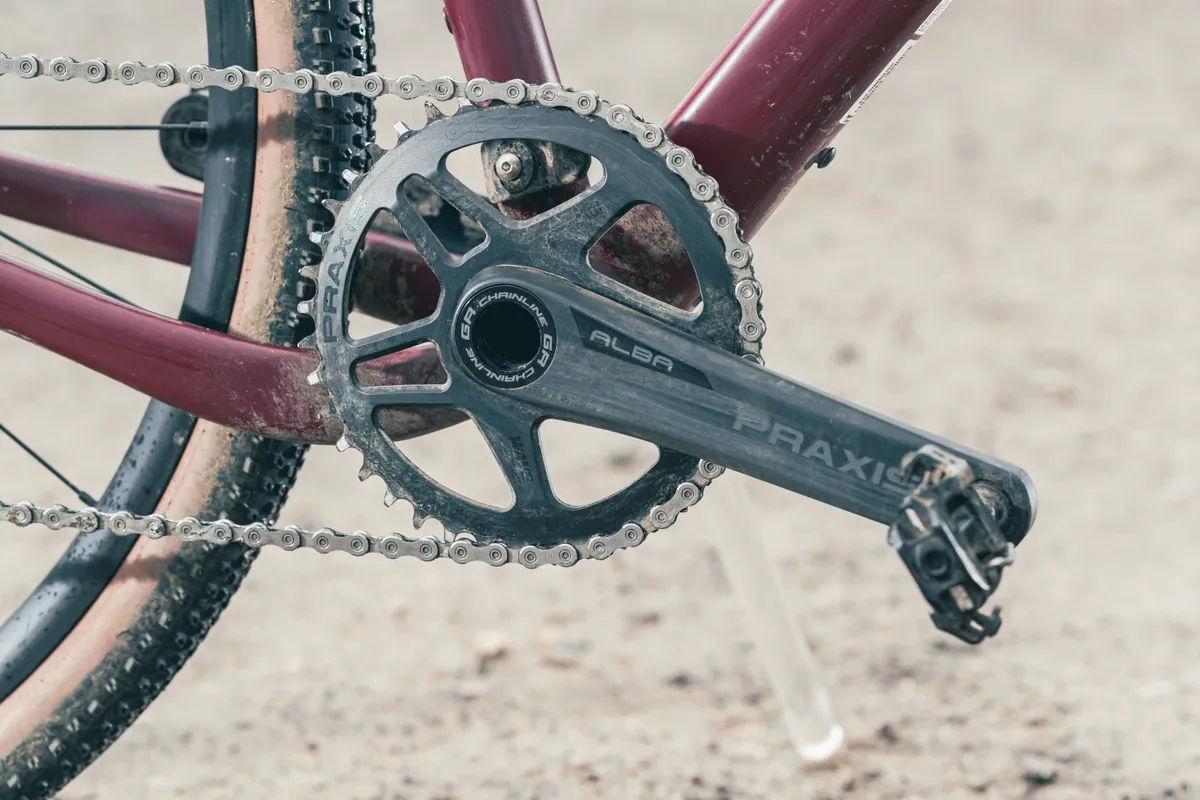
What is in keeping with a current gravel design trend is the dropped driveside chainstay, to provide clearance for 700x45mm gravel bike tyres. Although very reasonable, more adventure-focused bikes sport clearance for 50mm rubber or wider.
Trek says you can also fit 650b wheels with up to 2.1in-wide tyres, but advises to watch your pedals in the corners because the bottom bracket will be a touch lower.
The carbon fibre fork is carried over from the Checkpoint SL, albeit omitting a port in the steerer tube to route the hydraulic hose internally. The fork legs are fairly stout at the crown and taper as they reach the dropouts.
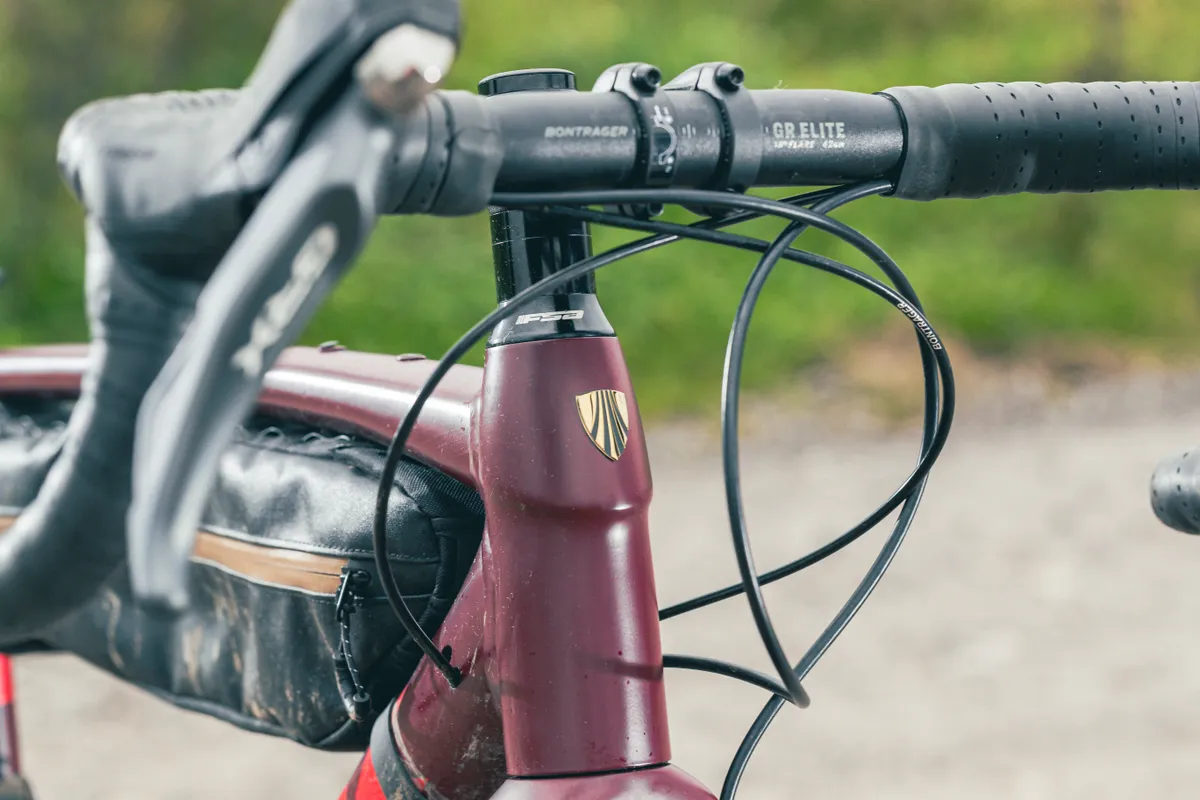
There is no shortage of mounting points on the Checkpoint ALR. You get five bosses on the down tube, so you can run either two bottle cages or a cage and a frame bag.
Three bosses bedeck the seat tube and there’s space for a bottle cage under the down tube as it meets the T47 bottom bracket junction.
What’s more, there’s room for a top tube bag and your choice of mudguards or a pannier (or both) thanks to mounts on the seatstays, as well as a removable seatstay bridge.
The fork has triple cage mounts if you need to carry even more cargo, with provision for mudguards, too.
The only thing the Checkpoint ALR is missing is internal routing in the fork for a dynamo.
Trek Checkpoint ALR 5 Driftless geometry
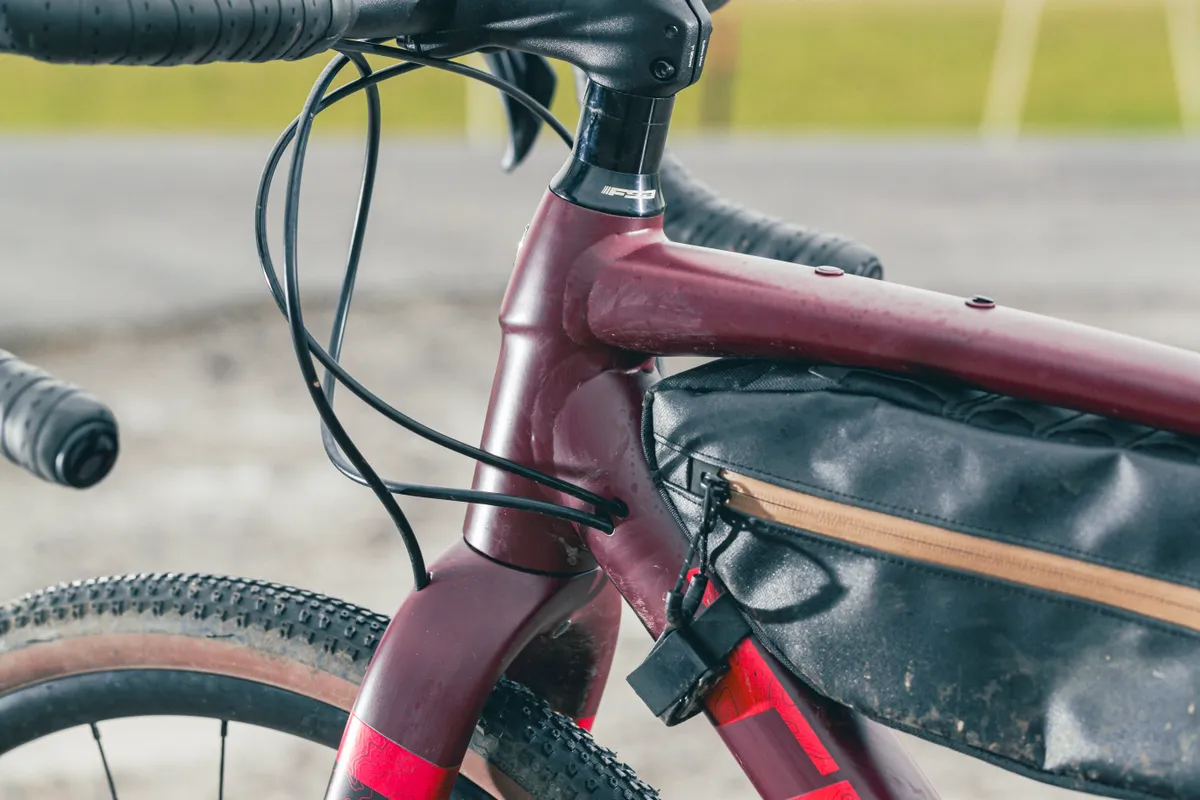
There aren’t many surprises to be found with the Checkpoint ALR’s geometry, which sticks firmly in the camp of road-bike inspired. For reference, I tested a size 56cm for my 5ft 11in height.
Still, it has morphed from its predecessor. The seat tube angle has been slackened by half a degree, the reach has lengthened, and the chainstays and wheelbase are longer, too.
Each size is also specced with a 10mm shorter stem, with my 56cm equipped with a 90cm option.
Trek says the geometry is “quick and nimble yet keeps you stable and in control on fast, choppy descents”.
The 72.2-degree head tube angle is at the steeper end of the spectrum, with Specialized’s Diverge at 71.75 degrees, and my reference bike, Niner’s RLT 9 RDO at 71.5 degrees, both in a size 56cm.
That slightly steeper head tube angle is paired with a slacker seat tube angle of 72.8 degrees, the Diverge trumping the Checkpoint (at 73.5 degrees) and the Niner (at 73 degrees).
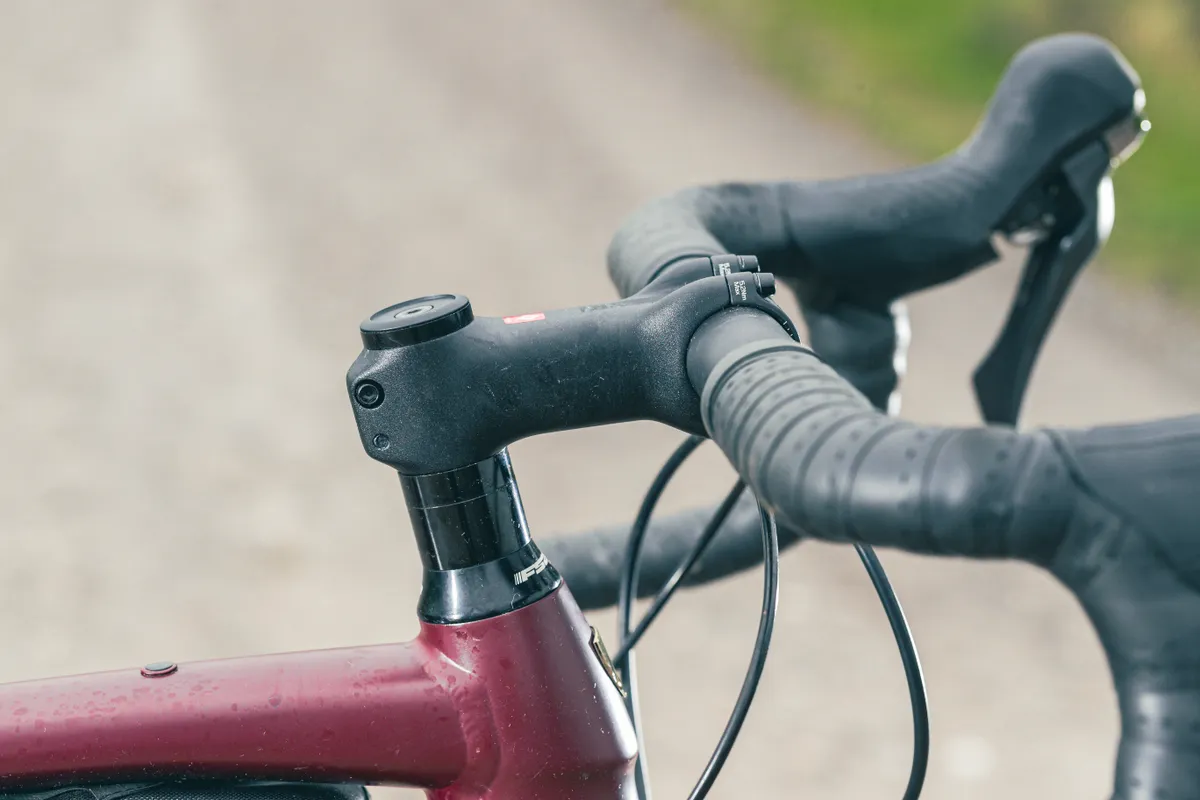
The 407mm reach is long, compared to the 392mm measurement on the Diverge and 384mm for the Niner.
Trek’s description of the bike as ‘stable’ is particularly apt, with a long 1,048mm wheelbase paired with a 435mm chainstay length.
Although the Diverge is comparable (1,049mm wheelbase and 432mm chainstays), many brands are now opting for shorter measurements to speed up the bike’s reactivity. The Marin Headlands I recently tested, for example, uses particularly short 420mm chainstays.
| Frame size (cm) | 49 | 52 | 54 | 56 | 58 | 61 |
|---|---|---|---|---|---|---|
| Head tube angle (degrees) | 71.2 | 71.6 | 71.8 | 72.2 | 72.3 | 72.6 |
| Head tube length (mm) | 90 | 105 | 125 | 145 | 165 | 195 |
| Seat tube angle (degrees) | 74.1 | 73.7 | 73.2 | 72.8 | 72.5 | 72.1 |
| Seat tube length (mm) | 490 | 520 | 540 | 560 | 580 | 610 |
| Effective top tube length (mm) | 541 | 555 | 570 | 584 | 597 | 617 |
| Chainstay length (mm) | 435 | 435 | 435 | 435 | 435 | 435 |
| Wheelbase (mm) | 1,025 | 1,033 | 1,041 | 1,048 | 1,058 | 1,070 |
| Reach (mm) | 393 | 399 | 403 | 407 | 411 | 417 |
| Stack (mm) | 538 | 553 | 571 | 592 | 609 | 639 |
Trek Checkpoint ALR 5 Driftless build
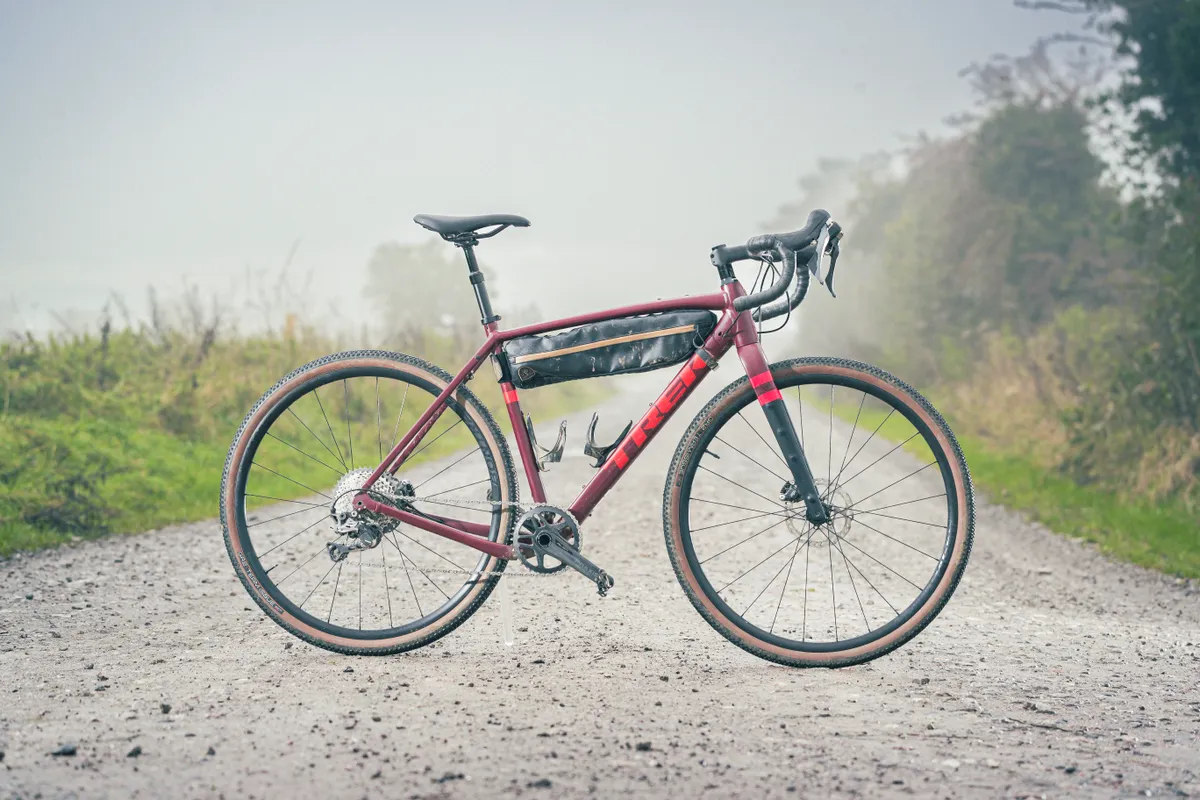
The Checkpoint ALR 5 Driftless sat at the top of Trek’s 2022 range for the model – I use the past tense because that’s changed for the recently announced 2023-24 bikes.
A frameset, in the matching ‘Satin Cobra Blood’ colourway of this build for 2024, retails for £1,300 / $1,299.99 / €1,399.
The Checkpoint ALR Driftless is specced with a predominantly Shimano GRX RX800 11-speed mechanical groupset. There’s some cost-cutting at the crankset though, with Trek officially speccing a one-rung-below RX600 offering.
My test bike came with a Praxis Alba crankset, though, and an upgraded XT (over the SLX) cassette, which Trek says is down to supply issues.
The Driftless runs on rolling stock from Bontrager (Trek’s in-house parts brand) – a set of Paradigm SL wheels paired with Bontrager GR2 Team Issue tyres in a 40mm width. The 24-spoked aluminium rims sport a 21mm internal rim width – pretty average, if on the narrow side, for gravel bike wheels.
They come set up almost ready for tubeless out of the box, with valves and rim tape installed. You just need to add sealant.
Bontrager’s also on finishing kit duties, with the exception of the Easton EA70 AX dropper post with 50mm travel. Be aware the 27.2mm diameter means it may not play nicely with some bikepacking bag adaptors.
The left-hand GRX-800 lever blade actuates the dropper post, which is a neat touch – there's nothing more displeasing to my eye than an ugly ancillary lever mounted on drop handlebars.
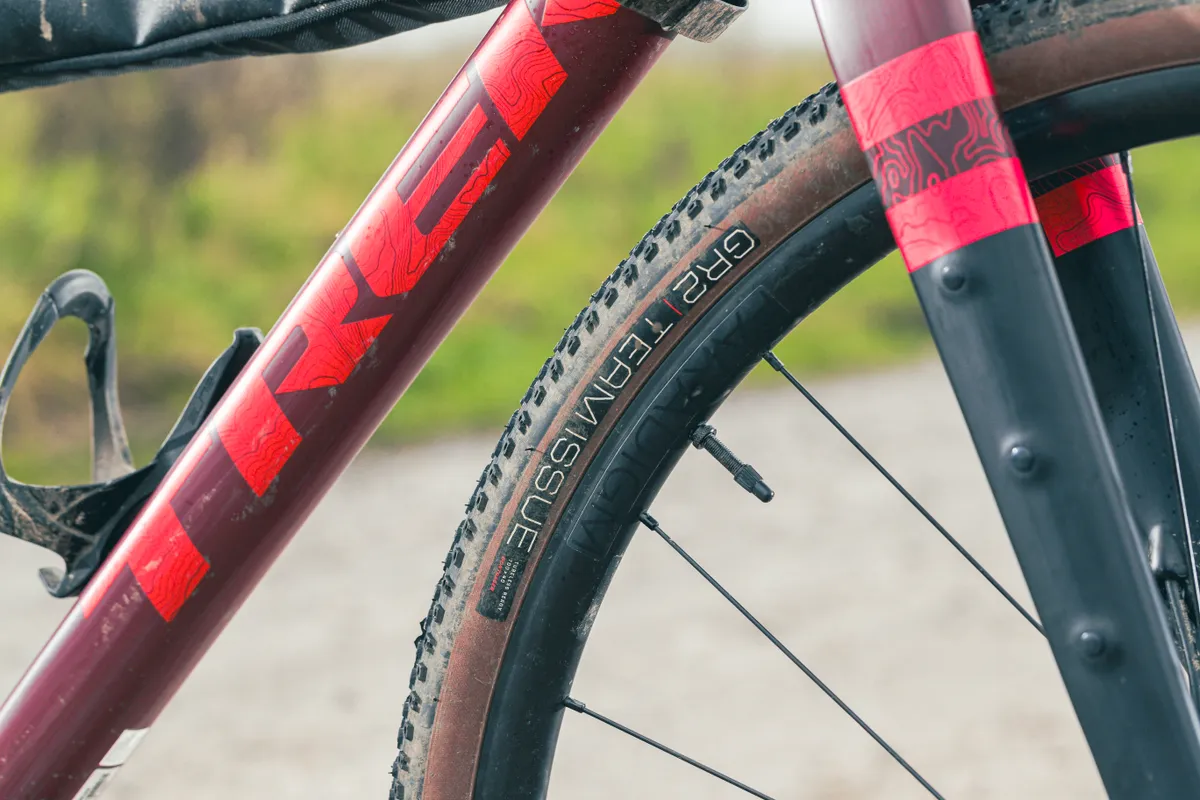
Trek has nailed the bike’s paint scheme and I appreciated the nods to the Driftless region, with the topographical lines inside the Trek down tube logos and on the fork legs. The graphics are all well-masked and the Satin Cobra Blood main colour is vivid and rich.
The included Adventure Boss frame bag is also a quality item – it’s easy to mount with a strap on the down tube and seat tube, as well as two threaded bosses into the underside of the top tube. The three-litre volume meant I could carry all my riding spares and more, and the bag shrugged off some foul weather.
On the scales, my 56cm test bike weighed in at 10.44kg, including the frame bag.
Trek Checkpoint ALR 5 Driftless performance
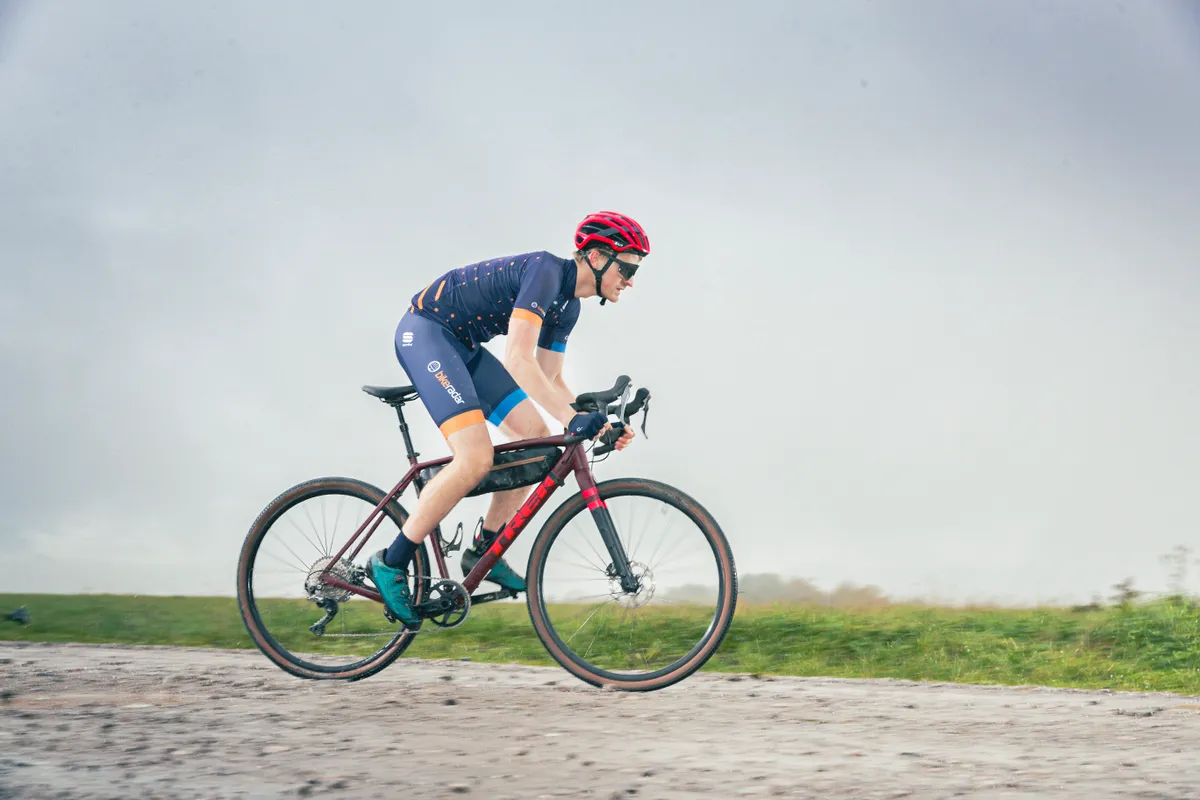
I tested the Checkpoint ALR 5 over the course of two months, from the end of summer heading into autumn, clocking just over 500km.
The bike was tested on trails in and around Bristol, in the south west of England, as well as my familiar Chiltern test loop in the south east.
Although I didn’t take the bike on a fully fledged bikepacking trip, the Checkpoint ALR was subjected to a 100km ride fully loaded to simulate a bikepacking scenario.
The Checkpoint is an easy bike to get on with, particularly if you’re coming from the tarmac, thanks to the neutral handling of its endurance road bike-like position.
Despite the heavy but dependable componentry, it’s a sharp-feeling frame and although it doesn’t respond with immediacy, it holds its speed well once you’ve accelerated.
That means it’s not in a particular rush to get you up sharp climbs and I’d have preferred a steeper seat tube angle so I could put more weight over the bottom bracket.

The long wheelbase means the Checkpoint ALR is a very stable platform for descending on the road or tame gravel. The bike’s at home on so-called princess gravel (a phrase lovingly coined by my colleague Robyn Furtado), with the confidence-inspiring upright geometry a solid basis for extended pedalling.
The Driftless area of the Midwest, on the doorstep of Trek’s Wisconsin headquarters, conjures images of expansive, sandy dirt tracks thanks to its thinly covered glacial drift. There’s no denying the bike would be just the ticket for that environment.
The Checkpoint ALR Driftless is less at home on technical terrain, though. You get a fair amount of feedback, particularly through the front end, and there was no doubt I was riding an aluminium bike, despite experimenting with the tyre pressures.
My wrists were certainly aware they’d been through a battle after a 100km test loop in the areas surrounding the city of Bath.
On a familiar flowy, but gulley-littered descent I had to hold off the gas so my body didn’t feel excessively pummelled at the bottom.
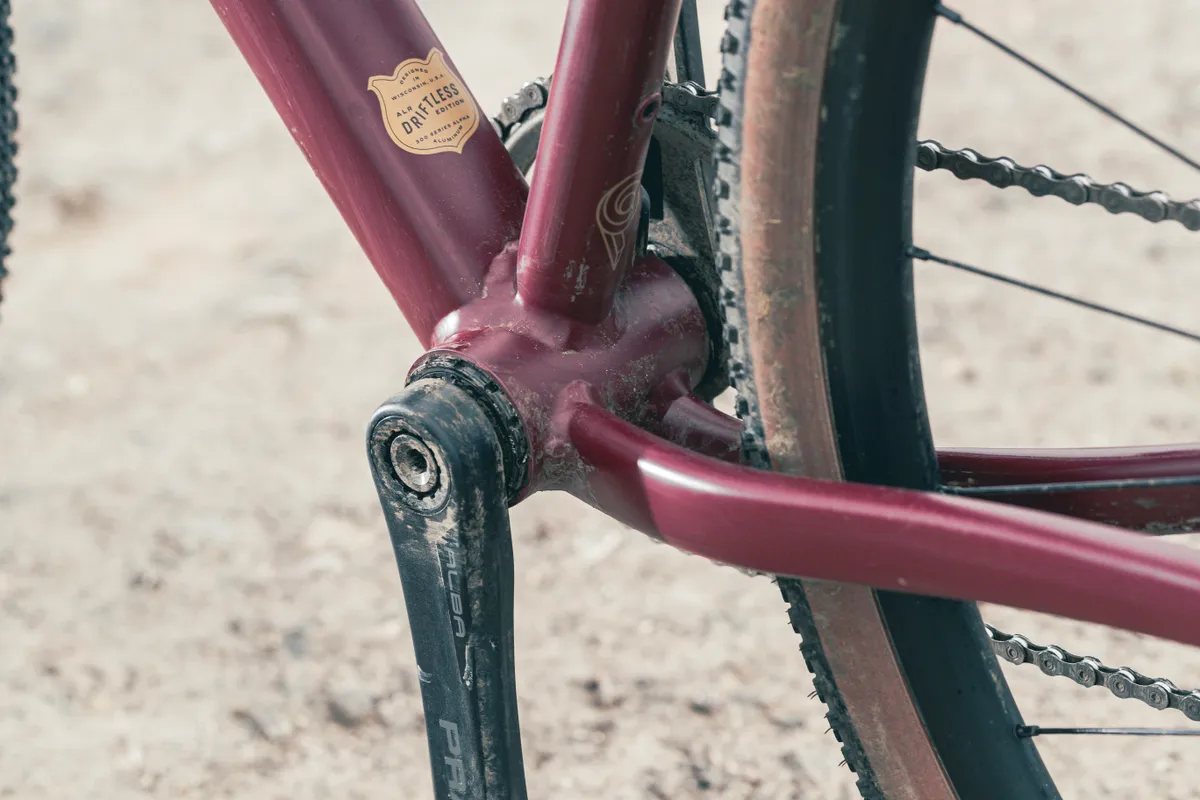
The relatively steep head tube angle almost certainly isn’t helping; a slacker measurement would roll better over obstacles and make the bike feel more confident.
Trek clearly intends for you to push your limits on the Checkpoint ALR, though, with the speccing of a dropper post a signal of intent.
I’d recommend fully utilising the 45mm tyre clearance if you’ll be heading on testing terrain, to dull the fairly rigid ride quality. You could also look to spec a carbon handlebar and seatpost to further boost compliance.
I found fully loading the bike with bikepacking bags improved its behaviour on technical terrain and my wrists didn’t feel as thrashed.
However, unlike the Surly Disc Trucker, which really came to life when loaded with a springy yet softening ride quality, the Checkpoint ALR didn’t offer the same level of excitement. That’ll be right up the avenue of some riders who want a bike that’s predictable and doesn’t offer any surprises. However, I’d have preferred a livelier feeling.
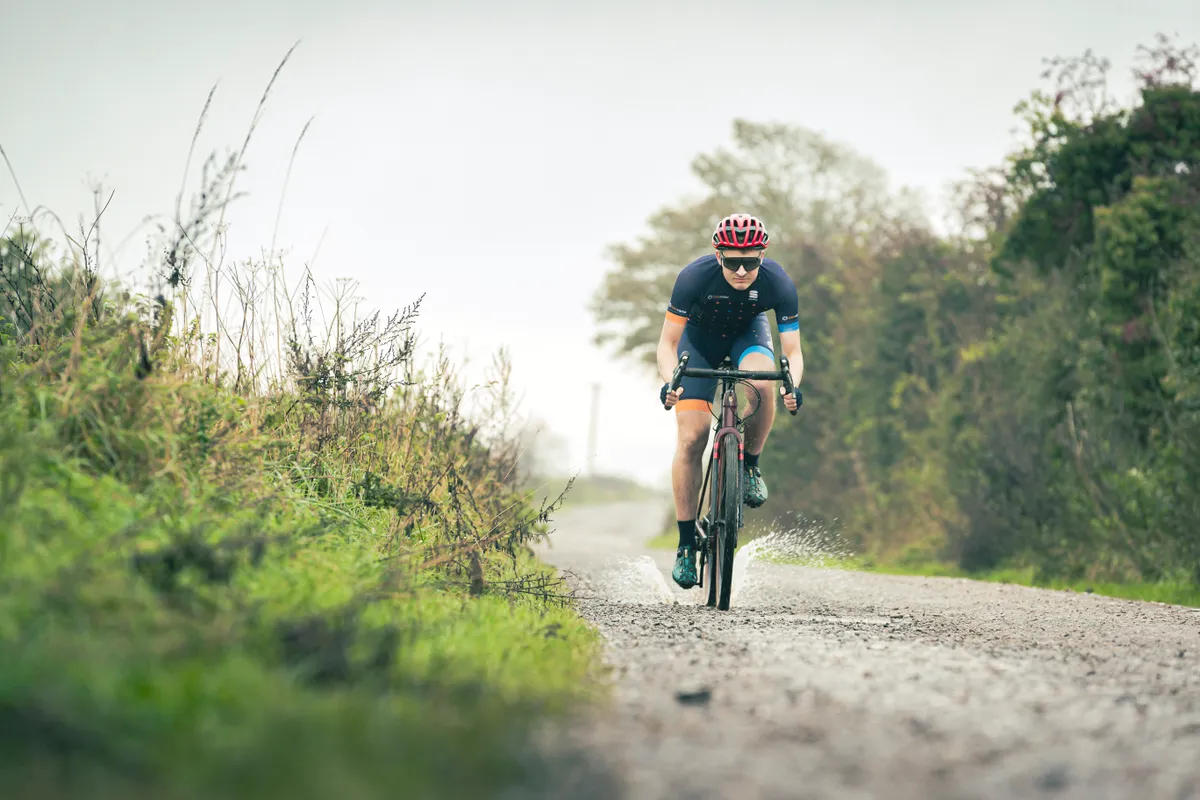
Moving onto the components, the Shimano GRX-800 11-speed groupset is a fine match for the Checkpoint, even if it has been superseded by a more up-to-date 12-speed version. The latest GRX ecosystem incorporates a more generous 10-51t cassette, which is significantly more bikepacking-friendly than the maximum 42t found here.
Although the 40-42 highest gear combination is fairly generous, there were times in testing when I wished for a more friendly climbing gear. This is interesting because the aforementioned Marin Headlands comes with a bigger 42t chainring, paired with an easiest 42t cog. However, the gear range on this bike felt more limiting. I’d put this down largely to the porkier overall bike weight.
Otherwise, the gravel groupset performed excellently. The shifting was crisp (although I wish Trek specced a genuine Shimano gear cable and housing) and the brakes were terrific.
It’s worth noting that my experience with Shimano brakes has been hit-and-miss in the past, but I found the combination of BR-RX810 caliper and SM-RT26 disc rotors to have lots of modulation, thanks in no small part to the non-linear ServoWave action.
The Paradigm SL wheels felt unremarkable. They’re heavy at 2,037g for the set (I weighed the front in at 909g and the rear 1,128g), but remained true through testing. I appreciated the included rim strip, which simply snaps into place rather than having to carefully tape it over the rim. That's something that makes tubeless setup more straightforward.
The GR2 Team Issue tyres performed solidly – they’re light at 422g and fast-rolling, but lack grip in the mud.
I swapped them out for a control tyre, the Pirelli Cinturato Gravel RC, and found these a better match.
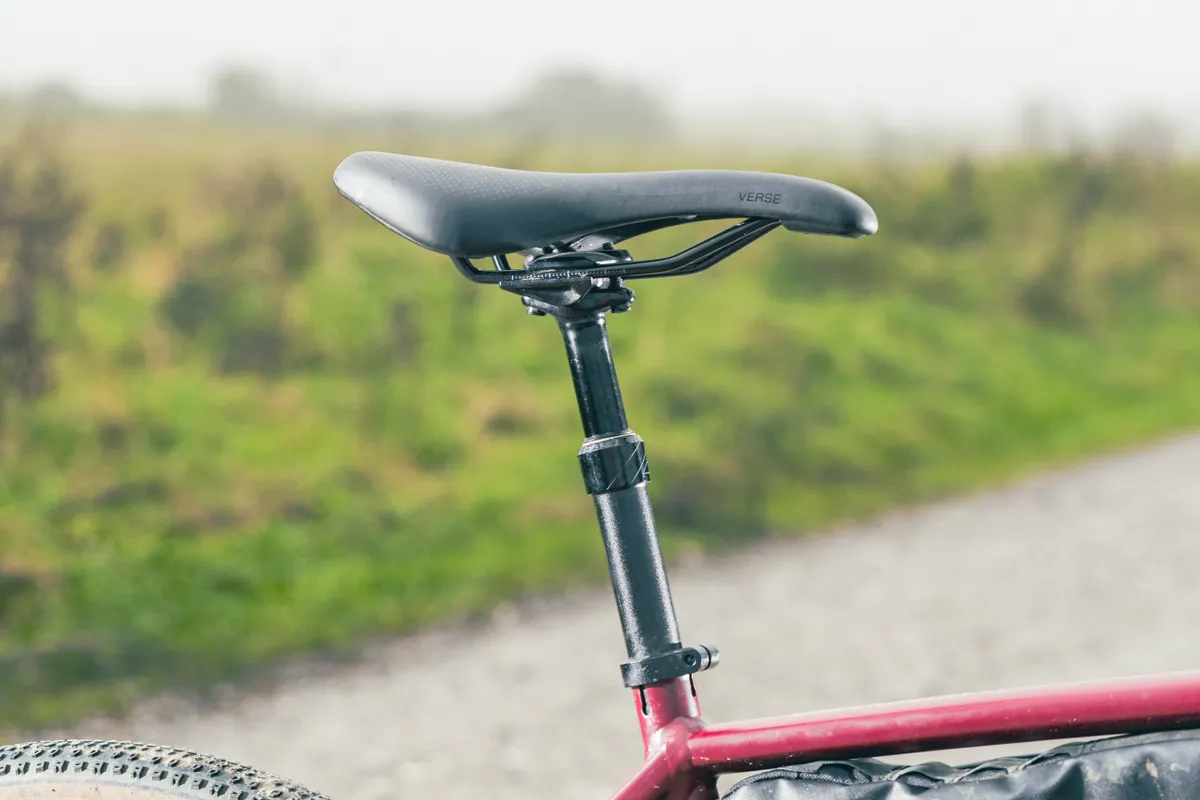
The Easton dropper post also performed well throughout testing, although I’d have preferred a longer drop than the 50mm offered to really get the saddle out of the way when getting carried away on rowdy descents.
The Bontrager Verse Comp saddle the bike was equipped with was comfortable and I didn’t see the need to change it during testing.
Comparative value
I can’t help but feel the Checkpoint ALR 5 isn’t the best value for money. It’s spendy at £2,700 and, while the spec is largely bombproof, it’s on the heavier side.
Marin’s Headlands 2 is £100 more and you step up to a full carbon fibre frame with a largely comparable spec. It has a significantly more agreeable ride quality in almost every way.
If you were to buy the Checkpoint ALR 5 Driftless with a view to upgrading items such as the wheels and finishing kit down the line to improve compliance, it would probably make sense to plump for the carbon Checkpoint SL 5 at £3,700.
Updates for 2023-24
The Checkpoint ALR 5’s frameset remains unchanged for Trek’s 2023-24 model year and will be offered in only two flavours.
The Checkpoint ALR 5 is specced almost identically to the Checkpoint ALR 5 Driftless, but incorporates a front derailleur for 2x gearing.
You miss out on a dropper post, with Trek speccing a Bontrager alloy option, as well as the frame bag. Trek claims a size 56cm weighs 9.75kg and the bike will retail for £2,500.
A Checkpoint ALR 5 AXS will also be an option for 2023/4, costing £3,000. The bike is specced with a SRAM Apex XPLR eTap AXS electronic groupset and an Easton EA70 AX dropper post. It’s also claimed to weigh 9.75kg in a size 56cm.
Trek Checkpoint ALR 5 Driftless bottom line
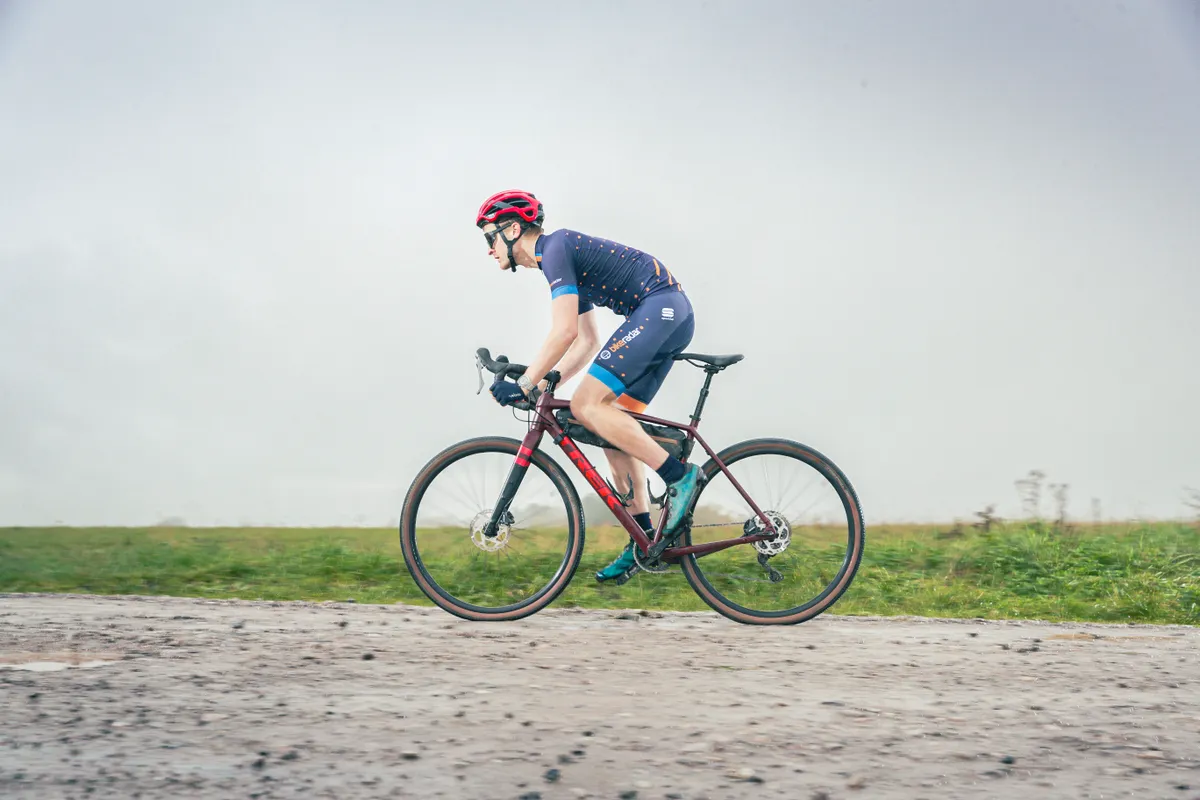
Trek’s Checkpoint ALR 5 Driftless is a successful aluminium gravel bike for the brand, although its road-based influence means it’s better suited to tamer terrain.
If you’re willing to put up with the additional weight over a Trek Domane ALR, the brand’s equivalent aluminium endurance bike, the Checkpoint ALR would make for a sound companion for winter road rides or commuting. Its sure-footed geometry is ideal for cracked and ruined backroads.
If your riding encompasses more technical terrain, this wouldn’t be my first choice. The front-end feels harsh and the geometry isn’t as progressive as some of its contemporaries.
Trek’s Checkpoint ALR 5 is perhaps best summed up as being like vanilla ice cream – it does what it’s designed to do well, but doesn’t rock the boat in any way.
Product
| Brand | Trek |
| Price | A$4695.95, €3220.00, £2700.00, $3280.00 |
| Weight | 10.44kg |
Features
| Fork | Checkpoint, full carbon, tapered carbon steerer, rack mounts, fender mounts, flat mount disc, 12x100mm thru axle |
| Stem | Bontrager Elite, 31.8 mm, Blendr-compatible, 7-degree |
| Chain | Shimano HG601, 11-speed |
| Frame | 300 Series Alpha Aluminium, tapered head tube, Internal cable routing, 3S chain keeper, T47 BB, rack and mudguard mounts, integrated frame bag mounts, flat-mount disc, 142x12 mm thru-axle |
| Tyres | Bontrager GR2 Team Issue, Tubeless Ready, Inner Strength casing, aramid bead, 120 tpi, 700x40mm |
| Brakes | Shimano RX810 hydraulic disc |
| Cranks | Shimano GRX RX600, 40T |
| Saddle | Bontrager Verse Comp, steel rails |
| Wheels | Bontrager Paradigm SL, Tubeless Ready, 21 mm rim width |
| Headset | FSA 1 1/8 to 1.5in |
| Shifter | Shimano GRX RX810, 11-speed |
| Cassette | Shimano SLX M7000, 11-42, 11 speed |
| Seatpost | Easton EA70 AX, 27.2 mm, 0 mm offset, 50 mm travel |
| Grips/tape | Bontrager Supertack Perf tape |
| Handlebar | Bontrager Elite Gravel |
| Bottom bracket | T47 |
| Available sizes | 49cm, 52cm, 54cm, 56cm, 58cm, 61cm |
| Rear derailleur | Shimano GRX RX812, long cage, 42T max cog |
